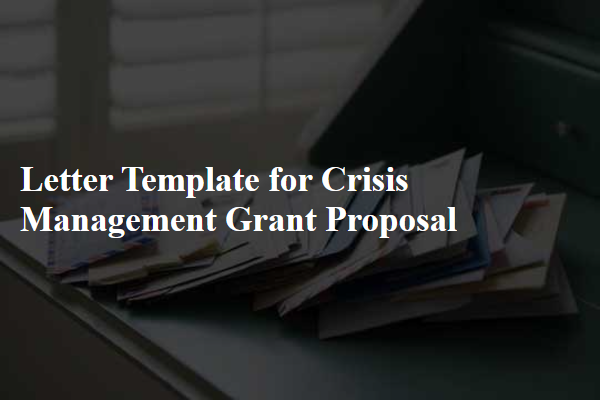In today's dynamic landscape, unforeseen crises can strike at any moment, leaving organizations scrambling for solutions. It's crucial to have a robust crisis management plan in place, and that's where a well-crafted grant proposal can make a significant difference. This article will guide you through the essential components of a compelling letter template for your crisis management grant proposal. Ready to discover how to elevate your proposal and secure the support you need? Let's dive in!

Clear and concise project description
A crisis management grant proposal aims to develop a comprehensive response plan to address the effects of natural disasters, such as hurricanes or wildfires, on local communities. This project will focus on three key areas: community preparedness, resource allocation, and post-crisis recovery. Community preparedness initiatives will include workshops and training programs designed to educate residents about emergency protocols, evacuation routes, and first aid procedures. Resource allocation efforts will analyze existing infrastructure, ensuring that essential supplies, such as food, water, and medical provisions, are stockpiled and accessible during crises. Post-crisis recovery strategies will emphasize psychological support services and community rebuilding efforts, specifically targeting mental health resources and economic assistance for affected families. Implementing this project in a region prone to disasters, like the Gulf Coast or California, aims to strengthen resilience, minimize loss, and enhance recovery capabilities for future crises.
Identification of the crisis and its impact
Recent wildfires in California have devastating effects on local communities, wildlife, and air quality. The 2023 wildfire season witnessed over 400,000 acres scorched, displacing thousands from their homes. Smoke inhalation led to a rise in respiratory illnesses among residents, particularly affecting vulnerable populations, such as children and the elderly. Local infrastructure damage, including the destruction of schools, hospitals, and emergency services, has hampered effective crisis response. Ecological impacts include habitat destruction for various endangered species, threatening biodiversity in regions such as the Sierra Nevada. The economic toll is significant, with estimated losses exceeding $1 billion, hindering recovery efforts and exacerbating poverty in affected areas.
Detailed budget and financial plan
A comprehensive budget and financial plan for a crisis management grant proposal outlines the allocation of resources essential for addressing specific challenges effectively. The budget should include line items such as personnel costs, encompassing salaries for crisis management experts and administrative staff, as well as benefits, which may range from 25% to 30% of salaries. Equipment expenses, including technological tools for communication and surveillance, might total approximately $15,000, ensuring operational efficiency during emergencies. Training sessions, crucial for enhancing skills in crisis response, can require about $10,000 for workshops and materials. The proposal should also incorporate a contingency fund, typically 10% of the total budget, to address unforeseen circumstances, ensuring financial resilience amid unpredictability. Lastly, grants from government entities like FEMA or nonprofit organizations should be identified to support the financing, providing a robust foundation for the proposed initiatives.
Measurable objectives and outcomes
Measurable objectives play a critical role in crisis management grant proposals, providing a clear framework for assessing success and effectiveness. An example of a measurable objective is to reduce response times for emergency services by 30% within the first six months of implementing new training programs. Additionally, increasing community engagement in disaster preparedness events by 50% within the next year can help create a more resilient population. Outcomes related to these objectives may include the number of incidents where response times improved, the percentage of community members participating in emergency drills, and satisfaction ratings from participants in training sessions. Implementing surveys and data collection methods such as event attendance tracking can further support the evaluation of these objectives. These measurable metrics ensure transparency in reporting progress and accountability in utilizing grant funds effectively.
Strong justification for grant necessity
The need for funding to support crisis management initiatives is underscored by the increasing frequency and severity of natural disasters, such as hurricanes (e.g., Hurricane Katrina in 2005), wildfires (like the California wildfires of 2020), and public health emergencies (the COVID-19 pandemic since 2020). These events have disrupted local communities, leading to significant economic losses estimated in billions of dollars annually. The role of comprehensive crisis management planning in minimizing such impacts is critical, particularly for vulnerable populations in high-risk areas, such as low-income neighborhoods in New Orleans and rural communities in California. Enhanced funding will enable the development of robust emergency response frameworks, investment in training for first responders, and the establishment of community awareness programs, ensuring preparedness and resilience against future crises. Data from the Federal Emergency Management Agency indicates that federal disaster relief funding often arrives too late or is inadequate for immediate needs, emphasizing the urgency of preemptive planning and local capacity building. Thus, securing this grant is vital for fostering a proactive approach to crisis management, safeguarding lives and property, and promoting long-term community recovery and sustainability.
Letter Template For Crisis Management Grant Proposal Samples
Letter template of appeal for resources in response to a crisis situation













Comments